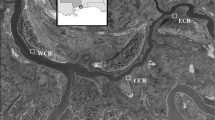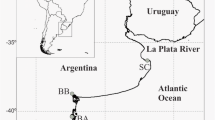Abstract
Sewage discharge is a common source of pollution in coastal marine waters. Several municipal treatment plants dump treated water in medium to fine sand Spisula subtruncata communities. This bivalve is generally considered a major food source for demersal fishes, and it is important as a dominant species in structuring the macrobenthic community during the spring and summer months. We sampled within five locations affected by sewage discharge along the Castellon coast (northwest Mediterranean Sea) where S. subtruncata (da Costa 1778) is a common bivalve. Van Veen grab samples were obtained for the study of the bivalve population and to characterize the sediment. The sewage discharges studied affect Spisula populations. In the stations near the outfalls, the abundance and the average size of S. subtruncata decreased. However, this effect did not correlate with sediment characteristics, such as granulometry or pH.






Similar content being viewed by others
References
Ajani PA, Roberts DE, Smith AK, Krogh M (1999) The effect of sewage on two bioindicators at Port Stephens, New South Wales, Australia. Ecotoxicology 8:253–267
Albertelli G, Chiantore M, Covazzi A (1994) Persistence and changes in suspension and deposit feeding species in a shallow soft-bottom macrobenthic community. Biol Mar Mediterranea 1(1):277–278
Albertelli G, Chiantore M, Covazzi A, Fraschetti S (2001) Temporal fluctuations in macrobenthos: A case study in the Ligurian Sea. Arch Oceanogr Limmol 22:183–190
Ambrose WGJ, Jones DS, Thompson I (1980) Distance from shore and growth rate of the suspension feeding bivalve, Spisula solidissima. Proc Natl Shellfisheries Assoc 70:207–215
Ambrogi R, Occhipinti Ambrogi A (1985) The estimation of secondary production of the marine bivalve Spisula subtruncata (da Costa) in the area of the Po River delta. Mar Ecol 6(3):239–250
Bothner MH, Casso MA, Rendigs RR, Lamothe PJ (2002). The effect of the new Massachusetts Bay sewage outfall on the concentrations of metals and bacterial spores in nearby bottom and suspended sediments. Mar Pollut Bull 44:1063–1070
Cardell MJ, Sardà R, Romero J (1999) Spatial changes in sublittoral soft-bottom polychaete assemblages due to river inputs and sewage discharges. Acta Oceologica 20:343–351
Cerrato RM, Keith DL (1992) Age structure, growth, and morphometric variations in the Atlantic surfclam, Spisula solidissima, from estuarine and inshore waters. Mar Biol 114:581–593
Chícharo L, Chícharo M, Gaspar M, Regala J, Alves F (2002) Reburial time and indirect mortality of Spisula solida clams caused by dredging. Fish Res 59:247–257
Corsi I, Mariotti M, Menchi V, Sensini C, Balocchi C, Focardi S (1992) Monitoring a marine coastal area: Use of Mytilus galloprovincialis and Mullus barbatus as bioindicators. Mar Ecol 23(Suppl. 1):138–153
Cotano U, Villate F (2006) Anthropogenic influence on the organic fraction of sediments in two contrasting estuaries: A biochemical approach. Mar Pollut Bull 52:404–414
Dauvin JC (1982) Impact of Amoco Cadiz oil spill on the muddy fine sand Abra alba and Melinna palmata community from the Bay of Morlaix. Estuar Coast Shelf Sci 14:517–531
Ellingsen KE (2002) Soft-sediment benthic biodiversity on the continental shelf in relation to environmental variability. Mar Ecol Progr Ser 232:15–27
Estacio FJ, García-Adiego EM, Fa DA, García-Gómez JC, Daza JL, Hortas F, et al. (1997) Ecological analysis in a polluted area of Algeciras Bay (Southern Spain): External “versus” internal outfalls and environmental implications. Mar Pollut Bull 34(10):768–779
Fraschetti S, Covazzi A, Chiantore M, Albertelli G (1996) Life-history traits of the bivalve Spisula subtruncata (da Costa) in the Ligurian Sea (North-Western Mediterranean): The contribution of newly settled juveniles. Scientia Marina 61(Suppl. 2):25–32
Folk RL (1980) Petrology of sedimentary rocks. Hemphill, Austin, TX
Gray JS, Mirza FB (1979) A possible method for detecting pollution induced disturbance on marine benthic communities. Mar Pollut Bull 10:142–146
Grant J, Cranford P, Emerson C (1997) Sediment resuspension rates, organic matter quality and food utilization by sea scallops (Placopecten magellanicus) Georges Bank. J Mar Res 55(5):965–994
Guerra-García JM, García-Gómez JC (2004) Soft bottom mollusc assemblages and pollution in a harbour with two opposing entrances. Estuar Coast Shelf Sci 60:273–283
Holme NA, McIntyre AD (1984). Methods for the study of marine benthos, second ed. Blackwell Scientific, London, UK
Hongguang M (2002) Spatial and temporal variation in surfclam (Spisula solidissima) larval supply and settlement on the New Jersey inner shelf during summer upwelling and downwelling. Estuar Coast Shelf Sci 62:41–53
Jones DS, Thompson I, Ambrose W (1978) Age and growth rate determinations for the Atlantic surfclam Spisula solidissima (Bivalvia: Mactracea) based on internal growth lines in shell cross-sections. Mar Biol 47:63–70
King CK, Dowse MC, Simpson SL, Jolley DF (2004) An Assessment of five Australian polychaetes and bivalves for use in whole-sediment toxicity tests: Toxicity and accumulation of copper and zinc from water and sediment. Arch Environ Contam Toxicol 47:314–323
Koop K, Hutchins P (1996) Disposal of sewage to the ocean―A sustainable solution? Mar Pollut Bull 33:121–123
Martínez J, Adarraga I (2003) Estructura y evolución temporal de los sedimentos y de las comunidades bentónicas afectadas por los vertidos de un colector de aguas residuales en San Sebastián (Guipúzcoa) (golfo de Vizcaya). Bol Inst Español Oceanogr 19(1–4):345–370
McGreer ER (1979) sublethal effects of heavy metal contaminated sediments on the bivalve Macoma Balthica (L.) Mar Pollut Bull 10:259–262
McGreer ER (1982) Factors affecting the distribution of the bivalve Macoma Balthica (L.) on a mudflat receiving sewage effluent, Fraser River Estuary. B C Mar Environ Res 7(2):131–149
McIntyre AD (1995) Human impact on the oceans: The 1990s and beyond. Mar Pollut Bull 31:147–151
Morrisey DJ, Turner SJ, Mills GN, Williamson RB, Wise BE (2003) Factors affecting the distribution of benthic macrofauna in estuaries contaminated by urban runoff. Mar Environ Res 55:113–136
Oliver BG, Niimi AJ (1988) Trophodynamic analysis of polychlorinated biphenyl congeners and other chlorinated hydrocarbons in the Lake Ontario ecosystem. Environ Sci Technol 22:388–397
Pearson TH, Rosenberg R (1978) Macrobenthic succession in relation to organic enrichment and pollution of the marine environment. Oceanogr Mar Biol Annu Rev 16:229–311
Pérês JM, Picard J (1964) Nouveau manuel de bionomie benthique de la mer Méditerranée. Bull Travaux Station Marine d’Endoume 31:1–138
Puente A, Juanes JA, García-Castrillo G, Álvarez C, Revilla JA, Gil JL (2002) Baseline study of soft bottom benthic assemblages in the Bay of Santander (Gulf of Biscay). Hydrobiologia 475/476:141–149
Riisgard HU, Larsen PS (2000). Comparative ecophysiology of active zoobenthic filter feeding: Essence of current knowledge. J Sea Res 44(3–4):169–193
Rueda JL, Smaal AC (2002) Physiological response of Spisula subtruncata (da Costa 1778) to different seston quantity and quality. Hydrobiologia 475/476:505–511
Rueda JL, Smaal AC (2003) Variation of the physiological energetics of the bivalve Spisula subtruncata (da Costa 1778) within an annual cycle. J Exp Mar Biol Ecol 301:141–157
Sánchez-Moyano JE, Estacio FJ, García-Adiego EM, García-Gómez JC (2000) The molluscan epifauna of the alga Halopteris scoparia in Southern Spain as a bioindicator of coastal environmental conditions. J Molluscan Stud 66:431–448
Sardá R, Pinedo S, Gremare A, Taboada S (2000) Changes in the dynamics of shallow sandy-bottom assemblages due to sand extraction in the Catalan Western Mediterranean Sea. ICES J Mar Sci 57:1446–1453
Sardá R, Pinedo S, Martin D (1996) Seasonal dynamics of macroinfaunal key species inhabiting shallow soft-bottoms in the Bay of Blanes (NW Mediterranean). Acta Oceologica 20(4):315–326
Simboura N, Zenetos A, Panayotidis P, Makra A (1995) Changes in benthic community structure along an environmental pollution gradient. Mar Pollut Bull 30(7):470–474
Smith SDA (1994) Impact of domestic sewage effluent versus natural background variability: An example from Jervis Bay, New South Wales. Aust J Mar Freshw Res 45:1045–1064
Smith J, Shackley SE (2006) Effects of the closure of a major sewage outfall on sublittoral, soft sediment benthic communities. Mar Pollut Bull 52(6):645–658
Snedecor GW, Cochran WG (1989) Statistical methods, 8th ed. Iowa State University Press, Ames, IA, pp 333–373
Snelgrove PVR, Grassle JP, Butman CA (1998) Sediment choice by settling larvae of the bivalve, Spisula solidissima (Dillwyn), in flow and still water. J Exp Mar Biol Ecol 231:171–190
Tebble N (1966) British bivalve seashells: A handbook for identification. The British Museum (Natural History), London, UK
Wade TL, Sericano JL, Gardinali PR, Wolff G, Chambers L (1998) NOAAs Mussel Watch Project: Current use organic compounds in bivalves. Mar Pollut Bull 37(1–2):20–26
Wagner ES (1984) Growth rate and annual shell structure patterns in a single year class of surfclams Spisula solidissima off Atlantic City, New Jersey (161 pp.). Master’s thesis, Rutgers University, New Brunswick, NJ
Warwick RM, Platt HM, Clarke KR, Agard J, Gobin J (1990) Analysis of macrobenthic and meiobenthic community structure in relation to pollution and disturbance in Hamilton Harbour, Bermuda. J Exp Mar Biol Ecol 138:119–142
Weinberg JR (1998) Density-dependent growth in the Atlantic surfclam Spisula solidissima off the coast of the Delmarva Peninsula, USA. Mar Biol 130:621–630
Weinberg JR, Helser TE (1996). Growth of the Atlantic surfclam Spisula solidissima from Georges Bank to the Delmarva Peninsula, USA. Mar Biol 126:663–674
Weissberger EJ, Grassle JP (2006) Settlement, first-year growth, and mortality of surfclams Spisula solidissima. Estuar Coast Shelf Sci 56:669–684
Widdows J, Donkin P (1992) Mussels and environmental contaminants: Bioaccumulation and physiological aspects. In: Gosling E (ed.) The mussel Mytilus: Ecology, physiology, genetics and culture. Volume 25. Development in aquaculture and fisheries science. Elsevier Science, Amsterdam, The Netherlands, pp 383–424
Winer BJ (ed) (1971) Multifactor experiments having repeated measures on the same elements. In: Statistical principles in experimental design, 2nd edn. McGraw-Hill, New York, pp 571–577
Acknowledgments
We gratefully acknowledge CONSOMAR S. A. and Entitat de Sanejament d´Aigües for financial contribution to this project. We also we thank the staff of the Department of Marine Sciences and Applied Biology, especially Y. Mugica, M. Diaz-Valdes, and C. Celdrán, for their inestimable collaboration and J. Templado of the National Museum of Natural Science of Madrid for help in identifying the bivalve.
Author information
Authors and Affiliations
Corresponding author
Rights and permissions
About this article
Cite this article
de la Ossa Carretero, J.A., del Pilar Ruso, Y., Giménez Casalduero, F. et al. Effect of Sewage Discharge in Spisula subtruncata (da Costa 1778) Populations. Arch Environ Contam Toxicol 54, 226–235 (2008). https://doi.org/10.1007/s00244-007-9031-3
Received:
Accepted:
Published:
Issue Date:
DOI: https://doi.org/10.1007/s00244-007-9031-3




